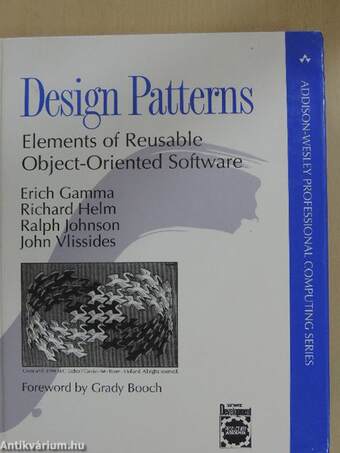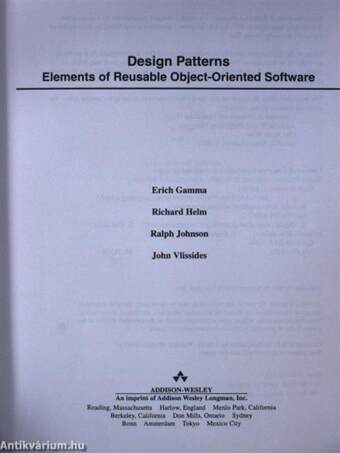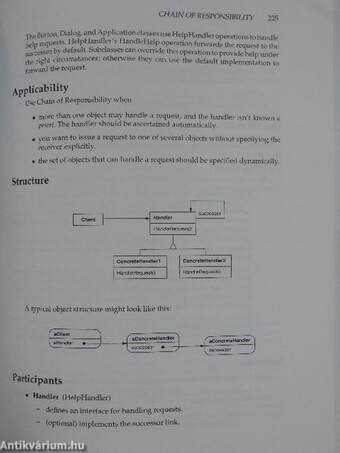1.063.133
kiadvánnyal nyújtjuk Magyarország legnagyobb antikvár könyv-kínálatát

VISSZA
A TETEJÉRE
JAVASLATOKÉszre-
vételek
Design Patterns
Elements of Reusable Object-Oriented Software
| Kiadó: | Addison-Wesley Press, Inc. |
|---|---|
| Kiadás helye: | Cambridge |
| Kiadás éve: | |
| Kötés típusa: | Fűzött kemény papírkötés |
| Oldalszám: | 395 oldal |
| Sorozatcím: | Addison-Wesley Professional Computing Series |
| Kötetszám: | |
| Nyelv: | Angol |
| Méret: | 24 cm x 19 cm |
| ISBN: | 0-201-63361-2 |
| Megjegyzés: | Fekete-fehér ábrákkal illusztrálva. |
naponta értesítjük a beérkező friss
kiadványokról
naponta értesítjük a beérkező friss
kiadványokról
Fülszöveg
Object-Oriented Technology FlpQKín Pflt+PTTi^ ,| Ü 2\ LfC'üJgil I dtUjlliü i ^ i "This book is an important contribution to practicing object designers and develope-s! Have you' ever tried to describe an idea that you don't have a preqise name for? It can be frustrating. Design Patterns organizes and presents a catalog of proven design idioms for structuring, creating, and manipulating pbjécts. Most importantly, it names these * design constructs, allowing teams to share a common vocabulary." - Rebecca J. Wirfs-Brock, Director, Object Technology Services, Digitalk "Design Patterns leaves the debates about code reuse behind and shows the real key to software reuse: reusable design. You'll find yourself applying and reusing these patterns in your own designs in no time." - Steve Vinóski, Software Architect "...IDesign Patterns] makes two important contributions. First, it shöws the role that patterns can play in architecting complex systems. Second, it provides a very pragmatic... TovábbFülszöveg
Object-Oriented Technology FlpQKín Pflt+PTTi^ ,| Ü 2\ LfC'üJgil I dtUjlliü i ^ i "This book is an important contribution to practicing object designers and develope-s! Have you' ever tried to describe an idea that you don't have a preqise name for? It can be frustrating. Design Patterns organizes and presents a catalog of proven design idioms for structuring, creating, and manipulating pbjécts. Most importantly, it names these * design constructs, allowing teams to share a common vocabulary." - Rebecca J. Wirfs-Brock, Director, Object Technology Services, Digitalk "Design Patterns leaves the debates about code reuse behind and shows the real key to software reuse: reusable design. You'll find yourself applying and reusing these patterns in your own designs in no time." - Steve Vinóski, Software Architect "...IDesign Patterns] makes two important contributions. First, it shöws the role that patterns can play in architecting complex systems. Second, it provides a very pragmatic reference to a set of well-engineered patterns that the practicing developer can apply to crafting his or her own specific applications,* - from the Foreword by Crady Booch, Chief Scientist, Rational Capturing a wealth of experience about the design of object-oriented software, four top-notch designers present a catalog of simple and succinct solutions to commonly occurring design problems. Previously undocumented, these 23 patterns allow designers to create more flexible, elegant, and ultimately reusable designs without having to rediscover the design solutions themselves. The authors begin by describing what patterns are and how they can help you design object-oriented software. They then go on to systematically name, explain, evaluate, and catalog recurring designs in object-oriented systems. With Design Patterns as your guide, you will learn how these important patterns fit into the software development process, and how you can leverage them to solve your own design problems most efficiently. Each pattern describes the circumstances in which it is applicable, when it can be applied in view of other design constraints, and the consequences and trade-offs of using the pattern within a larger design. All patterns are compiled from real systems and are based on real-world examples. Each pattern alsó includes code that demonstrates how it may be implemented in object-oriented programming languages like C++ or Smalltalk. The authors are internationally recognized experts in the object-oriented software field. Dr. Erich Gamma is technical director at the Software Technology Center of Object Technology International in Zürich, Switzerland. Dr. Richárd Helm is a member of the Object Technology Practice Group in the IBM Consulting Group in Sydney, Australia. Dr. Ralph Johnson is a faculty member at the University of Illinois at UrbanaChampaign's Computer Science Department. Dr. John Vlissides conducts his research at IBM's Thomas J. Watson Research Center in Hawthorne, New York. VisszaTartalom
ContentsPreface xi
Foreword xiii
Guide to Readers xv
1 Introduction 1
1.1 What Is a Design Pattern? . . . 2
1.2 Design Patterns in SmalltalkMVC 4
1.3 Describing Design Patterns 6
1.4 The Catalog of Design Patterns 8
1.5 Organizing the Catalog 9
1.6 How Design Patterns Solve Design Problems 11
1.7 How to Select a Design Pattern 28
1.8 How to Use a Design Pattern 29
2 A Case Study: Designing a Docuxnent Editor 33
2.1 Design Problems 33
2.2 Document Structure 35
2.3 Formatting 40
2.4 Embellishing the User Interface 43
2.5 Supporting Multiple Look-and-Feel Standards 47
2.6 Supporting Multiple Window Systems 51
2.7 User Operations 58
2.8 Spelling Checking and Hyphenation 64
viii CONTENTS
2.9 Summary 7(>
Design Pattern Catalog 79
3 Creational Patterns 81
Abstract Factory • • ' P®
Builder s? 97
Factory Method 107
117
Prototype
Singleton 127
Discussion of Creational Patterns I35
4 Structural Patterns 137
Adapter . . • . • ¦ ¦
Bridge 151
Composite 163
Decorator ." \ ' »jfi§H
Facade . 185
Flyweight 195
Proxy 20 7
Discussion of Structural Patterns 219
5 Behavioral Patterns 221
Chain of Responsibility 223
Command 233
Interpreter 243
Iterator 257
Mediator 273
Mementó 283
Observer 293
State 305
Strategy 315
CONTENTS ix
Template Method 325
Visitor 331
Discussion of Behavioral Patterns 345
6 Conclusion 351
6.1 What to Expect from Design Patterns 351
6.2 A Brief History 355
6.3 The Pattern Community 356
6.4 Anlnvitation 358
6.5 A Parting Thought 358
A Glossary : SSffe
B Guide to Notation 363
B.l Class Diagram . ; Ji^
B.2 Object Diagram 364
B.3 Interaction Diagram 366
C Foundation Classes
C.l List 369
C.2 Iterator 372
C.3 Listlterator 372
C.4 Point 373
C.5 Rect 374
Bibliography 375
Index 383
Témakörök
Megvásárolható példányok
Nincs megvásárolható példány
A könyv összes megrendelhető példánya elfogyott. Ha kívánja, előjegyezheti a könyvet, és amint a könyv egy újabb példánya elérhető lesz, értesítjük.







